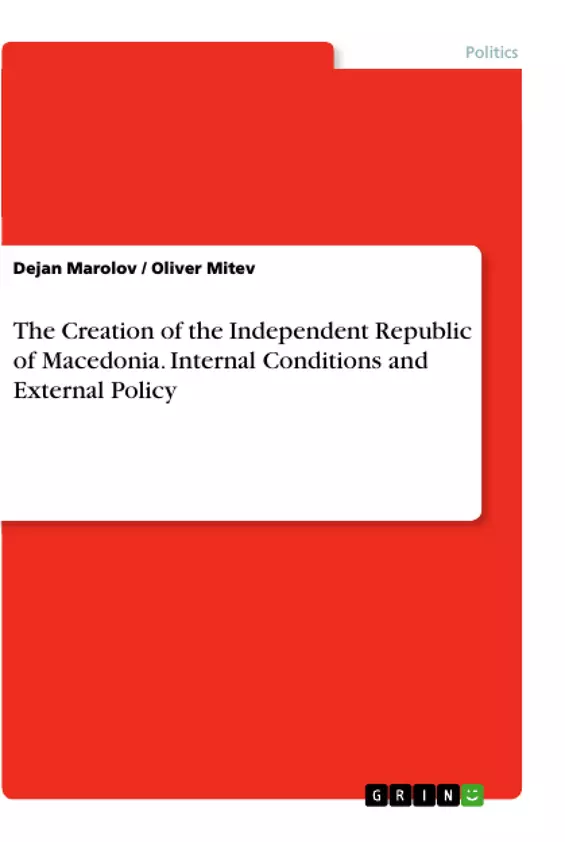In this work, the authors raise several questions and dilemmas related to the process of the independence of the Republic of Macedonia. Thus, it necessarily begins with the structural reform of the former Yugoslav federation, created by the intense changes caused by liberalism and nationalist currents in the 1970s. This results in constitutional changes and substantial decentralization of the federation, with the constitution of 1074 becoming the owners of their own sovereignty as federal entities. This fact precisely, in the formal legal sense, will be crucial for the successful independence of the Republic of Macedonia. However, the process is influenced by various factors, from geopolitical global shifts to regional and local conflicts, and the onset of the violent disintegration of SFR Yugoslavia. Furthermore, this book deals with specific issues related to the controversy over the referendum, the status and threat of the Yugoslav People's Army presence, foreign policy relations and issues related to international recognition, the blockade by the Republic of Greece and the beginning of the name dispute, and also the dilemmas related to the accession of the Republic of Macedonia to the UN.
The process of creating the independent Republic of Macedonia is parallel to all of the global processes of disintegration of the former East European one-party systems, including the former SFR Yugoslavia and the promotion of political pluralism and democracy as basic constituents of the modern societies. The Macedonian independence was established with the referendum of September 8, 1991. After this, the period of internal consolidation and the diplomatic fight for international recognition followed. The diplomatic initiatives, as well as overall relations with the EC and the USА, resulted with the membership of Republic of Macedonia (under the temporary reference of the Former Yugoslav Republic of Macedonia) in United Nations.
In the period that followed, as a result of the wider international intervention in former Yugoslavia and the blockade from Greece, Macedonia was in a very difficult and complex situation. Due to the so-called Name Issue, Greece imposed onside trade embargo and blockade for further integration in other international organizations and initiatives. The status quo situation was changed with Interim accord, after which the period of stabilization and establishing of relation with USA and most of EU countries followed.
Inhaltsverzeichnis (Table of Contents)
- Introduction
- Chapter 1
- THE DISINTEGRATION OF SFRY
- The 1974 Constitution and the Transformation of the SFRY
- Tito's Death and Internal Turmoil
- Beginning of End
- Reasons for Disintegration
- Chapter 2
- INDEPENDENCE OF THE REPUBLIC OF MACEDONIA
- The Process of Independence
- Security Issues and Dealing with the Danger of Possible Spillover of the Yugoslav Crises in Macedonia
- The Process of Securing Complete Independence and Sovereignty: Withdrawal of YNA from Macedonia
- CHAPTER 3
- INTERNATIONAL RECOGNITION OF THE REPUBLIC OF MACEDONIA
- Recognition of Macedonia and Admission to the UN
- The Dispute with Greece over their Name and Embargo
- Foreign Policy and Diplomacy 1993-1995
- Achieving the 1995 Interim Agreement
- CHAPTER 4
- EU-US RELATIONSHIP WITH THE FRAMEWORK OF YUGOSLAVIA AND THEIR POLICIES TO MACEDONIA
- EU and US Foreign Policy towards Processes in the Country
- US and EU Policy towards Macedonia at the Time of the Yugoslav Crisis
Zielsetzung und Themenschwerpunkte (Objectives and Key Themes)
This book aims to provide a retrospective and analytical presentation of the processes leading to the independence of the Republic of Macedonia. It explores the events and factors that contributed to the disintegration of SFRY, the challenges faced by Macedonia during the process of achieving independence, and the complexities of international recognition and diplomatic relations.
- The disintegration of SFRY and its impact on the Republic of Macedonia
- The process of independence of the Republic of Macedonia
- The challenges of international recognition and the name dispute with Greece
- The role of US and EU policies in the context of the Yugoslav crisis and Macedonia's independence
- The historical continuity of the Macedonian national consciousness and its role in the independence movement
Zusammenfassung der Kapitel (Chapter Summaries)
Chapter 1 focuses on the disintegration of the Socialist Federal Republic of Yugoslavia (SFRY), examining the 1974 Constitution and its role in transforming the federation, the impact of Tito's death and internal turmoil, and the reasons behind the ultimate collapse of the country. Chapter 2 delves into the independence of the Republic of Macedonia, covering the process of independence itself, the security issues related to the Yugoslav crisis, and the steps taken to secure complete independence and sovereignty, including the withdrawal of the Yugoslav People's Army. Chapter 3 examines the international recognition of the Republic of Macedonia, exploring the challenges of securing recognition, the dispute with Greece over the country's name, and the development of foreign policy and diplomacy between 1993 and 1995. Chapter 4 analyzes the EU-US relationship with Yugoslavia and their policies towards Macedonia, focusing on the EU and US foreign policy towards the region during the Yugoslav crisis and the specific policies implemented regarding Macedonia.
Schlüsselwörter (Keywords)
Key terms and concepts in this work include the disintegration of SFRY, the independence of the Republic of Macedonia, international recognition, the name dispute with Greece, US and EU foreign policy, the Yugoslav crisis, the Macedonian national consciousness, and the historical continuity of the Macedonian identity.
- Quote paper
- Dr. Dejan Marolov (Author), Oliver Mitev (Author), 2019, The Creation of the Independent Republic of Macedonia. Internal Conditions and External Policy, Munich, GRIN Verlag, https://www.grin.com/document/512844



